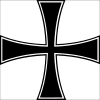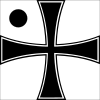Military ranks of the German Empire
The military ranks of the German Empire were the ranks used by the military of the German Empire. It inherited the various traditions and military ranks of its constituent states.
Ranks of the Imperial German Army
The German Army from 1871 to 1914 inherited the various traditions and military ranks of its constituent states, thus becoming a truly federal armed service.
Enlisted (Mannschaften/Gemeine) ranks
- Musketeer (Musketier, Prussian army infantry regiments), Infantryman (Infanterist, Bavarian army infantry regiments), Soldier (Soldat, Saxon army infantry regiments), Gunner (Kanonier, foot artillery), Pioneer (Pionier, pioneer branch). Other unit-specific enlisted ranks were: Fusilier (Füsilier), Grenadier (Grenadier), Huntsman otherwise Light-Infantryman (Jäger), Dragoon (Dragoner), Hussar (Husar), Cuirassier (Kürassier), Uhlan (Ulan), Fusilier Guard (Garde-Füsilier), Grenadier Guard (Garde-Grenadier), etc.
- Lance Corporal (Gefreiter); up until 1918 the only rank (with exception of Obergefreiter in the foot artillery) to which an enlisted soldier could be promoted, the rank was a deputy rank to the Corporal (Unteroffizier)[lower-alpha 1] rank.[2]
- Senior Lance Corporal (Obergefreiter); established in the Prussian Army from 1846 to 1853, reestablished in 1859, then in foot artillery only, replacing the artillery Bombardier rank that had been introduced in 1730.[2]
Additionally, the following voluntary enlistees were distinguished:
- One-Year Volunteer Enlistee (Einjährig-Freiwilliger): despite the name, one-year volunteers were actually conscripts who served a short-term form of active military service, open for enlistees up to the age of 25. Such enlisted soldiers were usually high school graduates (Matura, Abitur), who would opt to serve a one-year term rather than the regular two or three-year conscription term, with free selection of their chosen military service branch and unit, but throughout were obligated to equip and subsist themselves at entirely their own cost. In today's monetary value, this could at bare minimum cost some 10,000 euro, which purposely reserved this path open to officer-material sons from mostly affluent social class families wishing to pursue the Reserve-Officer path; it was the specific intention of Wilhelm II that such Reserve-Officer career path should only be open to members of so-called "officer-material" social classes.[3] On absolving their primary recruit training and shorter military service term, those aspiring to become Reserve-Officers would have to qualify and achieve suitability for promotion to the Gefreiter rank and then would continue to receive further specialized instruction until the end of their one-year term, usually attaining and leaving as surplus Corporals (überzählige Unteroffiziere) (Reservists), with the opportunity to advance further as reservists. Enlistees who did not aspire to officer grade would leave at the end of their one-year term as Gemeine[lower-alpha 2] (Ordinary soldier) enlisted rank (for example Musketier or Infanterist) and a six-year reserve duty obligation.[3] Eligibility for this specific one-year path of military service was a privilege approved upon examining the enlistee's suitability and academic qualifications.
- Long-Term Volunteer Enlistee "Capitulant" (Kapitulant): enlisted soldiers who had already absolved their regular two or three-year military conscription term and had now volunteered to continue serving for further terms, minimum was 4 years, generally up to 12 years.[5][lower-alpha 3]
Note: Einjährig-Freiwilliger and Kapitulant were not ranks as such during this specific period of use, but voluntary military enlistee designations. They, however, wore a specific uniform distinction (twisted wool piping along their shoulder epaulette edging for Einjährig-Freiwilliger, the Kapitulant a narrow band across their lower shoulder epaulette) in the colours of their respective nation state. This distinction was never removed throughout their military service nor during any rank grade advancements.
Non-commissioned officers / Unteroffiziere

Junior NCOs (NCOs without Sword Knot) / Unteroffizier ohne Portepee
Senior NCOs (NCOs with Sword Knot) / Unteroffizier mit Portepee
- Sergeant Major 2nd class (Infantry: Vice-Feldwebel, Cavalry and Artillery: Vizewachtmeister/Vice-Wachtmeister) – rank held by reserve officer candidates after they passed lieutenant's examination
- Sergeant-Major (Infantry: Feldwebel (i.e. Etatmäßiger Feldwebel: CSM officially listed on the regiment's payroll, i.e. Etat), Cavalry and Artillery: (Etatmäßiger) Wachtmeister)
Warrant Officers and Officer Cadets
- Cadet (Fahnenjunker, ranking between Sergeant and Vizefeldwebel) – served as cadets in the various military academies and schools.
- Ensign (Fähnrich, ranking between Vize-Feldwebel and Etatmäßiger Feldwebel)
- Deputy Officer (Offizierstellvertreter, ranking above Etatmäßiger Feldwebel)
- Acting Lieutenant (Feldwebelleutnant, ranking as youngest 2nd Lieutenant, but without officer's commission and still member of the NCO's Mess until 1917)
Officer corps
Critics long believed that the Army's officer corps was heavily dominated by Junker aristocrats, so that commoners were shunted into low-prestige branches, such as the heavy artillery or supply. However, by the 1890s, the top ranks were opened to highly talented commoners.[7][8]
Subalterns / Subalternoffiziere
| Designation | Subalterns | ||||
|---|---|---|---|---|---|
| Rank insignia | Shoulder |  |
 |
 |
 |
| Rank designation | Hauptmann/Kapitän I Klasse: infantry and artillery Rittmeister I Klasse: cavalry | Hauptmann/Kapitän II Klasse: infantry and artillery Rittmeister II Klasse: cavalry | Oberleutnant Feuerwerksoberleutnant | Leutnant: infantry, cavalry and other arms Feuerwerksleutnant: artillery | |
| (English designation) | Captain | Staff Captain[lower-alpha 4] | 1st Lieutenant | 2nd Lieutenant | |
Staff Officers / Stabsoffiziere
| Designation | Staff Officers | |||
|---|---|---|---|---|
| Rank insignia | Shoulder | .gif) |
.gif) |
.gif) |
| Rank designation | Oberst | Oberstleutnant | Major | |
| (English designation) | Colonel | Lieutenant Colonel | Major | |
General Officers / Generäle
| Designation | General Officers | ||||||
|---|---|---|---|---|---|---|---|
| Rank insignia | Shoulder |  |
 |
 |
.gif) |
 |
 |
| Rank designation | Generalfeldmarschall | Generaloberst mit dem Rang als Generalfeldmarschall | Generaloberst | General der Waffengattung | Generalleutnant | Generalmajor | |
| (English designation) | General Field Marshal | Colonel General in the rank of Field Marshal | Colonel General | General of the branch | Lieutenant General | Major General | |
Naval ranks and ratings
The Imperial German Navy's rank and rating system combined that of Prussia's with the navies of other northern states.
Seamen
| Designation | Seamen | |||
|---|---|---|---|---|
| Rank insignia [9] | Sleeve |  |
 |
 |
| Rank designation | Obermatrose | Einjährig-Freiwilliger | Matrose | |
| (English designation) | Seaman 1st Class | Seaman Volunteer (i.e.: Reserve Officer Candidate) | Seaman | |
Petty Officers
| Designation | Senior Petty Officers | Junior Petty Officers | |||
|---|---|---|---|---|---|
| Rank insignia [9] | Sleeve |  |
 |
 |
 |
| Rank designation | Feldwebel | Vize-Feldwebel | Obermaat | Maat | |
| (English designation) | Chief Petty Officer 1st Class (with additional stripe around the sleeve) | Chief Petty Officer | Petty Officer 1st Class | Petty Officer | |
Warrant Officers
| Designation | Warrant officers | |||
|---|---|---|---|---|
| Rank insignia [9] | Shoulder | .gif) |
 |
 |
| Rank designation | Deckoffiziere als Offizier-Stellvertreter | Oberdeckoffizier | Deckoffizier | |
| (English designation) | Chief Warrant Officer as Acting Commissioned Officer. | Chief Warrant Officer | Warrant Officer | |
| Specialty designations | Offizier-Stellvertreter | Oberbootsmann Obersteuermann Oberfeuerwerker | Bootsmann Steuermann Feuerwerker | |
| (English designation) | Acting Commissioned Officer | Chief Boatswain Chief Mate Chief Feuerwerker | Boatswain Mate Feuerwerker | |
Officer cadets
| Designation | Officer cadets | |||
|---|---|---|---|---|
| Rank insignia [9] | Shoulder |  |
 | |
| Sleeve |  |
 |
 | |
| Rank designation | Oberfähnrich zur See | Fähnrich zur See | Seekadett | |
| (English designation) | Midshipman | Sea cadet | Junior sea cadet | |
Naval officers
| Designation | Naval Officers | |||||||
|---|---|---|---|---|---|---|---|---|
| Rank insignia [9] | Shoulder |  |
 |
 |
 |
 |
 |
 |
| Sleeve |  |
 |
 |
 |
 |
 |
 | |
| Rank designation | Kapitän zur See | Fregattenkapitän | Korvettenkapitän | Kapitänleutnant | Oberleutnant zur See | Leutnant zur See | Deckoffizier- Leutnant | |
| (English designation) | Captain at Sea | Frigate Captain | Corvette Captain | Captain Lieutenant | Over-Lieutenant at Sea | Lieutenant at Sea | Deck Officer Lieutenant (from 1916) | |
Flag Officers
| Designation | Flag Officers | ||||
|---|---|---|---|---|---|
| Rank insignia [9] | Shoulder | _b.gif) |
 |
 |
 |
| Sleeve |  |
 |
 |
 | |
| Command flag |  |
 |
 |
 | |
| Rank designation | Großadmiral | Admiral | Vizeadmiral | Konteradmiral | |
| (English designation) | Grand Admiral | Admiral | Vice Admiral | Rear Admiral | |
Notes
- Duden; Origin and meaning of "Korporal", in German.[1]
- Duden; Definition of "Gemeine", in German.[4]
- Duden; Definition of "Kapitulant", in German.[6]
- Several German armies and national contingents, including Prussia and Bavaria, traditionally used two different captain ranks that originated with the ownership of units. By the end of the 19th century that dual-system had been gradually phased out and replaced by a single rank.
References
| Wikimedia Commons has media related to Military rank insignia of the German Empire. |
- Korporal
- "Gefreiter" – Allgemeine Encyclopädie der Wissenschaften und Künste, Erste Section, A-G, (Universal Encyclopaedia of the Sciences and Arts, First Section, A-G), Author: Johann Samuel Ersch and Johann Gottfried Gruber, Publisher: F. A. Brockhaus, Leipzig, 1852, Page 471-472, in German.
- Meyers Konversations-Lexikon, 4th Edition, Volume 6, Bibliographisches Institut, Leipzig 1885–1892, Page 659. in German
- Gemeine Buchstabe Soldat
- Meyers Konversations-Lexikon, 4th Edition, Volume 10, Bibliographisches Institut, Leipzig 1885–1892, Page 116, in German
- Kapitulant
- Ulrich Trumpener, "Junkers and Others: The Rise of Commoners in the Prussian Army, 1871–1914," Canadian Journal of History (1979) 14#1 pp 29–47
- Dennis E. Showalter, "The Political Soldiers of Bismarck's Germany: Myths and Realities," German Studies Review (1994) 17#1 pp. 59–77 in JSTOR
- "Dienstgrade und Uniformen." Kleinen Kreuzers “Dresden” (I). Retrieved 2017-09-22.